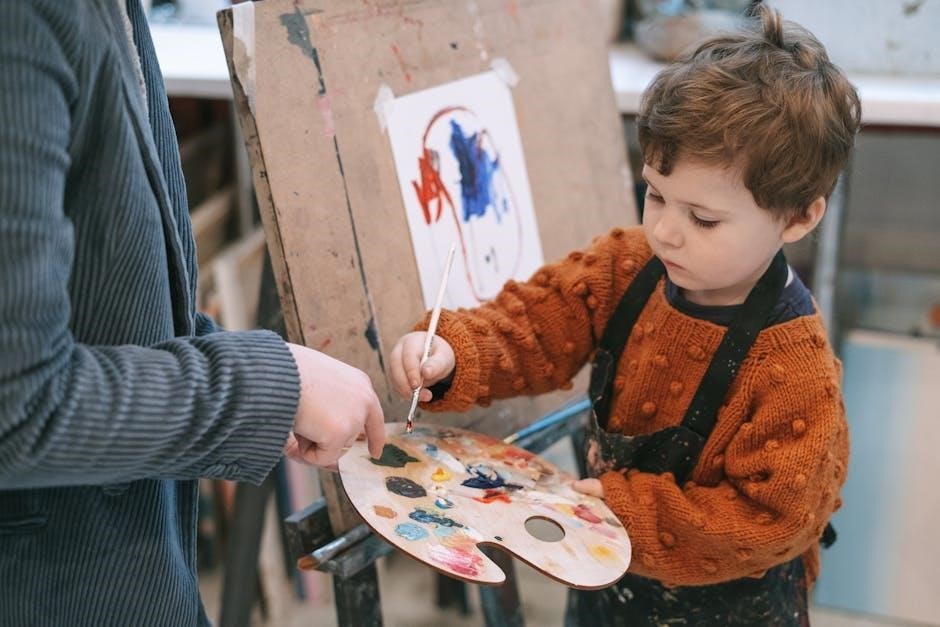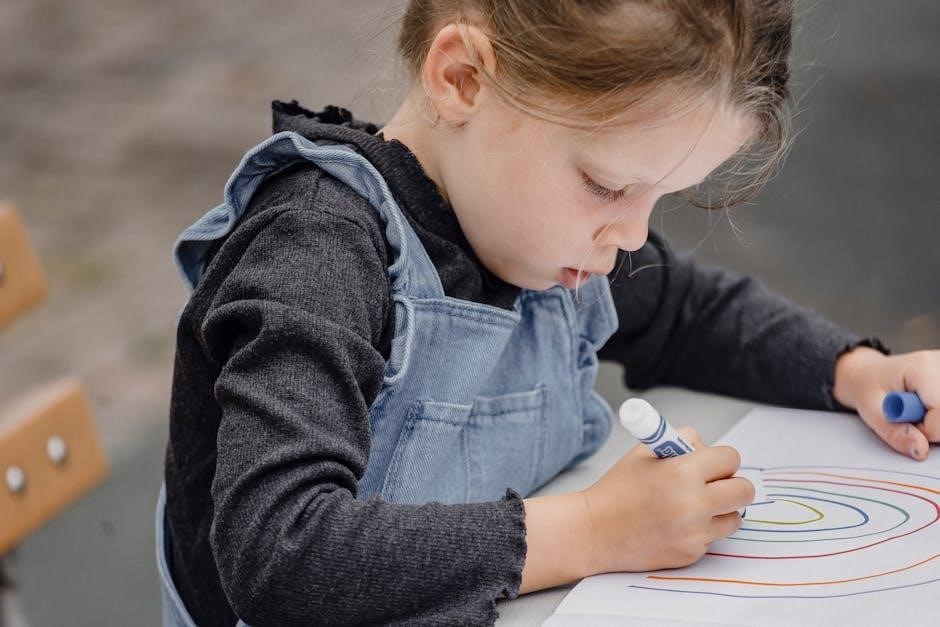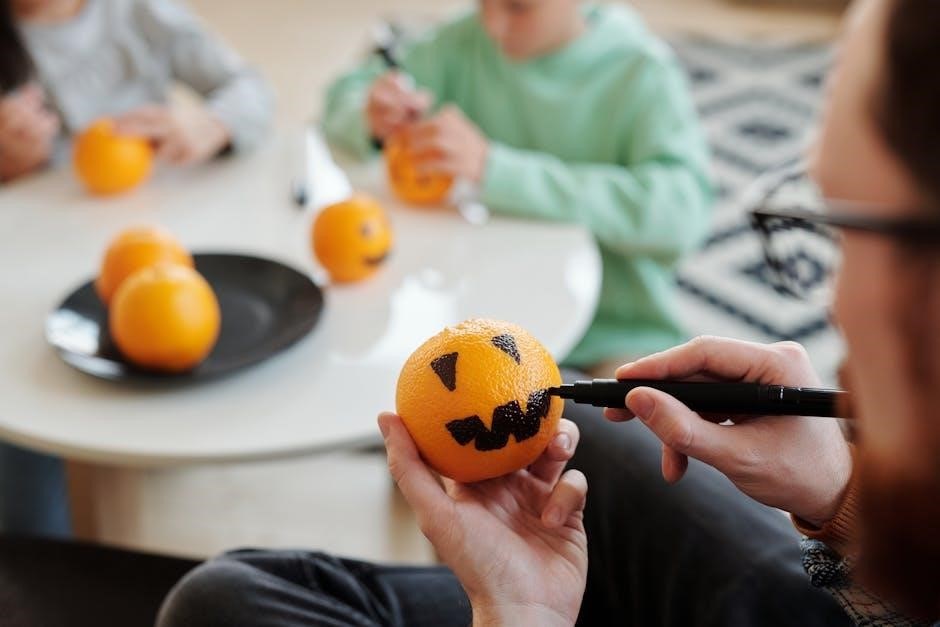Listen and Draw activities are engaging exercises where adults follow verbal instructions to create drawings, fostering active listening, creativity, and imagination without questions or visual cues.
1.1 What is a Listen and Draw Activity?
A Listen and Draw activity is an engaging exercise where adults follow verbal instructions to create drawings, fostering active listening and creativity. Participants listen carefully to directions without asking questions or receiving visual cues, interpreting the instructions in their unique way. This activity enhances imagination and artistic expression, as individuals translate auditory guidance into visual representations. It is widely used in educational and workplace settings to improve communication skills and encourage teamwork. The absence of visual aids challenges participants to rely solely on their listening abilities, making it an effective tool for developing attention and comprehension. It’s a fun, interactive way to engage adults creatively while improving their listening skills.
1.2 Why Use Listen and Draw Activities for Adults?
Listen and Draw activities are highly effective for enhancing listening skills, boosting creativity, and fostering confidence in artistic expression. They provide a unique opportunity for adults to engage in a fun, interactive learning experience that challenges their ability to interpret and execute verbal instructions accurately. These activities are particularly beneficial in workplace training and educational settings, as they promote teamwork, communication, and problem-solving. By focusing solely on auditory cues, participants develop their attention and comprehension abilities. Additionally, the creative freedom allows individuals to express their unique perspectives, making it a therapeutic and enjoyable way to build self-confidence and reduce stress. This makes it an ideal activity for diverse groups, encouraging collaboration and creative thinking while improving essential life skills.

Benefits of Listen and Draw Activities
Listen and Draw activities enhance listening skills, boost creativity, and encourage active participation, fostering confidence in artistic expression and improving overall communication and collaboration abilities in adults.
2.1 Enhancing Listening Skills
Listen and Draw activities significantly improve listening abilities by requiring participants to focus intently on verbal instructions. Adults must interpret descriptions, sequences, and details accurately to create precise drawings. This process sharpens auditory processing, memory retention, and comprehension. By eliminating visual cues, the brain relies solely on auditory input, enhancing concentration and reducing distractions. Over time, such exercises train individuals to capture key information efficiently, making them better listeners in both personal and professional settings. The clarity and accuracy of the final drawing reflect the quality of listening, providing immediate feedback for skill improvement.
2.2 Promoting Creativity and Imagination
Listen and Draw activities serve as a powerful tool for fostering creativity and imagination in adults. By relying solely on verbal instructions, participants are encouraged to interpret and visualize information in their own unique way. This process sparks imagination, as individuals translate abstract descriptions into tangible drawings. The absence of visual cues allows for diverse interpretations, leading to a wide range of creative outcomes. Such exercises not only enhance artistic expression but also empower adults to think outside the box, exploring their creative potential. This freedom of interpretation makes the activity a rewarding outlet for self-expression and innovation, regardless of artistic skill level.
2.3 Encouraging Active Participation
Listen and Draw activities are designed to engage adults fully, ensuring active participation through focused listening and creative execution. By following verbal instructions without visual cues, participants must concentrate intently, fostering a deeper connection to the task. The absence of questions or clarifications encourages individuals to trust their interpretation, making the process inherently interactive. This shared experience creates a sense of community, as everyone works toward the same goal. The activity’s structure ensures that all participants are equally involved, regardless of artistic skill, promoting a collaborative and dynamic environment where everyone contributes actively. This collective engagement enhances the overall learning and creative experience.
2.4 Building Confidence in Artistic Expression
Listen and Draw activities empower adults to express their creativity confidently. By focusing solely on verbal instructions, participants embrace their unique interpretations, understanding that there’s no right or wrong outcome. This freedom from criticism allows individuals, especially those hesitant about their artistic skills, to explore and experiment without fear. The process fosters self-expression and reinforces the idea that art is subjective. Sharing their work with others further builds confidence, as participants realize the value of their creative perspectives. This supportive environment helps adults overcome insecurities, encouraging them to view art as a form of personal expression rather than a perfection-driven task. Engagement and enjoyment are prioritized, making artistic expression accessible to all.

Preparing for the Activity
Gather materials like paper, pencils, and markers, and set up a quiet, well-lit space free from distractions to ensure participants can focus on the instructions and drawing.
3.1 Gathering Materials
To ensure a smooth and enjoyable experience, gather essential materials such as paper, pencils, markers, erasers, and sharpener. Provide additional tools like colored pens or crayons for creativity.
3.2 Setting Up the Environment
Create a comfortable and distraction-free space for the activity. Arrange seating to ensure participants can focus on the instructions. Provide good lighting and ventilation for a relaxed atmosphere. Place examples of previous drawings nearby for inspiration. Ensure all materials are within easy reach to avoid interruptions. Encourage a calm and creative mindset by minimizing noise and interruptions. This setup helps adults focus on listening and drawing effectively, fostering engagement and imagination throughout the session.

Step-by-Step Instructions
Begin with the facilitator providing clear, concise instructions. Participants listen attentively and draw based on the given directions. Finally, everyone shares their artwork for feedback.
4.1 Providing Clear Instructions
Clear instructions are essential for the success of a Listen and Draw activity. The facilitator should deliver instructions verbally, ensuring they are concise and easy to follow. Avoid ambiguity or complex language to prevent confusion. Each instruction should be given one at a time, allowing participants to process and act without overwhelming them. Repetition of key details can help, but questions should not be allowed to maintain the challenge of relying solely on listening. This approach ensures participants stay focused and engaged, fostering a productive and enjoyable experience while honing their listening and creative skills simultaneously.
4.2 The Drawing Phase
During the drawing phase, participants translate the verbal instructions into visual representations. This step encourages creativity and imagination, as adults interpret the guidance in their unique way. The environment should be calm, allowing individuals to focus solely on their artwork. Materials like paper, pens, and colored pencils are essential tools for this phase. Emphasize that the quality of the drawing matters less than the process of listening and creating. Participants are encouraged to let their imagination flow, even if their artistic skills are basic. The drawing phase typically lasts 5-10 minutes, depending on the complexity of the instructions. This step fosters a sense of accomplishment and readiness for sharing their work.
4.3 Sharing and Feedback
After completing their drawings, participants share their work with the group. This phase encourages communication and collaboration, as individuals explain their interpretations of the instructions. Feedback is provided constructively, focusing on creativity rather than technical skill. Sharing fosters a sense of community and allows participants to see how others visualized the same instructions. It also highlights the diversity of interpretations, emphasizing that there is no “right” or “wrong” outcome. This step reinforces listening skills by comparing how closely the final drawings align with the original instructions. Sharing and feedback make the activity engaging and educational, leaving participants with a sense of accomplishment and insight.

Tips for Facilitating the Activity
Create a relaxed environment, use clear instructions, and encourage creativity. Allow time for interpretation and ensure participants feel comfortable sharing their work without fear of judgment.
5.1 Encouraging Imagination
Encouraging imagination is key to maximizing the creative potential of Listen and Draw activities. Facilitators should emphasize that there are no right or wrong interpretations of the instructions, allowing participants to freely express their unique perspectives. Providing open-ended prompts or themes can further inspire creativity, as adults are encouraged to think beyond literal translations and explore abstract concepts. Additionally, sharing examples of diverse interpretations can demonstrate the value of different creative approaches. By fostering an environment where imagination is celebrated, participants are more likely to engage deeply and produce meaningful, personal artistic expressions that reflect their individuality and innovative thinking.
5.2 Managing Time Effectively
Effective time management is crucial for ensuring a smooth and productive Listen and Draw session. Facilitators should set clear timeframes for each phase of the activity, allowing participants enough time to complete their drawings without feeling rushed. Providing regular updates on the remaining time can help participants stay focused and prioritize their efforts. Incorporating short breaks or transitions between instructions can also maintain engagement and prevent fatigue. By balancing structure with flexibility, facilitators can ensure the activity stays on track while accommodating the diverse pacing of participants; This approach fosters a balanced and efficient learning environment, maximizing the benefits of the exercise.

Common Challenges and Solutions
Addressing diverse skill levels and misinterpretations is key. Encourage creativity over perfection and provide clear instructions to minimize confusion, ensuring all participants feel comfortable and engaged in the activity.
6.1 Addressing Diverse Skill Levels
When conducting listen and draw activities for adults, it’s essential to accommodate participants with varying artistic skills. Provide simple, clear instructions and emphasize creativity over technical precision. Encourage individuals to interpret directions in their own unique way, fostering a non-judgmental environment. Offer optional guides or examples for those who need inspiration. By focusing on the process rather than the outcome, everyone can engage meaningfully, ensuring the activity remains enjoyable and inclusive for all skill levels. This approach promotes participation and reduces anxiety, making the exercise beneficial for everyone involved.
6.2 Handling Misinterpretations
Misinterpretations are natural in listen and draw activities, as individuals may visualize instructions differently. To address this, provide clear, step-by-step directions and allow time for clarification. Encourage participants to ask questions after the drawing phase to ensure understanding. Sharing the final results can highlight creative variations, demonstrating that diverse interpretations are valid. Emphasize that there are no “right” or “wrong” outcomes, fostering a supportive environment. Use feedback sessions to discuss common misunderstandings and refine communication strategies for future activities, ensuring everyone feels comfortable and engaged throughout the process.

Variations of the Activity
Explore themed drawing activities or incorporate non-verbal cues to enhance engagement. Add music or time constraints for added challenge, fostering creativity and adaptability among participants in unique ways.
7.1 Incorporating Non-Verbal Cues
Incorporating non-verbal cues adds a dynamic layer to Listen and Draw activities. Participants can use gestures, facial expressions, or body language to convey instructions, enhancing engagement and creativity. For example, a facilitator might mime drawing shapes or point to colors, encouraging adults to interpret and visualize without verbal guidance. This variation challenges participants to rely on observation and intuition, fostering a deeper connection between non-verbal communication and artistic expression. It also encourages creativity, as interpretations of cues can vary widely, leading to diverse and imaginative outcomes. This approach is particularly effective for breaking language barriers and fostering teamwork in group settings. It enhances the overall experience by making it more interactive and immersive.
7.2 Themed Drawing Activities
Themed Drawing Activities add structure and inspiration to Listen and Draw sessions, focusing on specific topics like nature, technology, or pop culture. These themes guide participants’ creativity, ensuring their drawings align with a common concept. For example, a nature theme might involve describing landscapes or wildlife, while a technology theme could focus on gadgets or futuristic designs. Themed activities enhance engagement by providing clear direction and sparking imagination. They also allow participants to explore diverse subjects, making the experience more enjoyable and meaningful. This approach is ideal for adults seeking creative challenges and inspiration, as it combines listening skills with artistic expression tailored to a specific subject. Themes can be rotated to keep activities fresh and exciting.
Listen and Draw activities enhance creativity, listening skills, and imagination, providing a fun and engaging way for adults to express themselves artistically and connect with others meaningfully.
8.1 Summarizing the Experience
The Listen and Draw activity offers a memorable experience, combining creativity with focused listening. Participants enhance their ability to interpret verbal instructions while expressing their unique artistic vision. This engaging exercise fosters collaboration and camaraderie, as adults share their interpretations and gain insights into diverse perspectives. The activity not only strengthens listening skills but also builds confidence in artistic expression. Many participants report feeling a sense of accomplishment and joy in creating something meaningful. The shared experience often leads to lively discussions and a deeper understanding of how others perceive and interpret the same instructions. It’s a fulfilling way to connect through art and words.

Additional Resources
Explore books like The Art of Listening and Creative Drawing Exercises for advanced techniques. Visit websites like GoodListeningSkills.org for step-by-step guides and activity ideas.

9.1 Recommended Materials
Essential materials include high-quality sketch paper, colored pencils, markers, and erasers. Digital tools like drawing tablets or apps can enhance creativity. Access instructional guides from GoodListeningSkills.org for structured activities, ensuring a productive and engaging experience for participants. These resources provide step-by-step instructions, making it easier to facilitate sessions effectively.

9.2 Further Reading
For deeper exploration, explore resources like “Active Listening Games and Exercises for Adults” on GoodListeningSkills.org. This site offers detailed guides and activities to enhance listening skills. Additionally, ESL Listening Activities for Adults provides creative approaches to improve auditory comprehension. Books such as “The Art of Listening” and online courses on platforms like Coursera can further enrich your understanding. These resources provide practical exercises, expert tips, and innovative methods to refine listening abilities and integrate them into daily life effectively. They cater to both personal growth and professional development, ensuring comprehensive skill enhancement.

